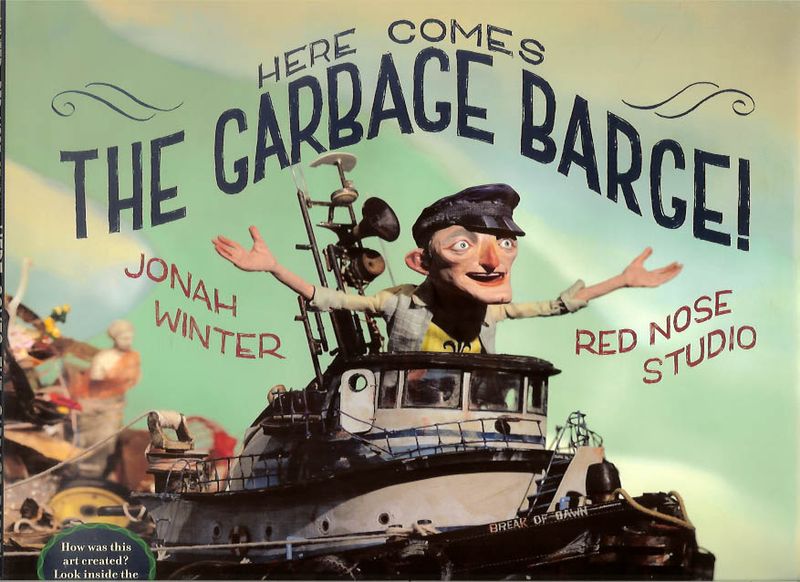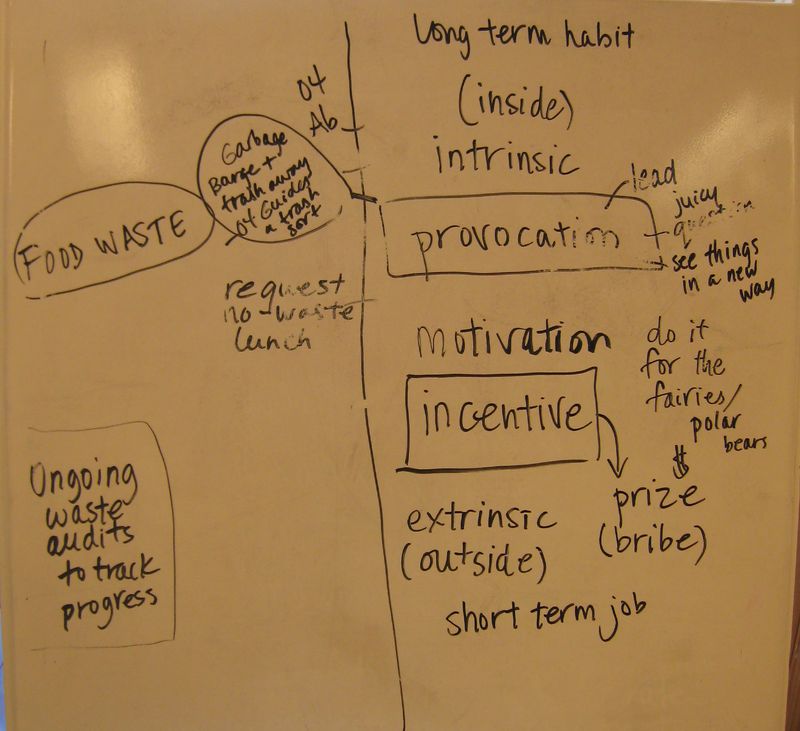Talking Trash: How will children plan to provoke other children to care?

On October 12, 2011, Levia gathered Opal 4 together for a discussion.
Levia: Do you remember that we did that trash audit when school started and presented our findings at Morning Gathering? Do you also remember that we left the school with a challenge? We asked them, “What can you do to lower these numbers?” Well, as far as I know, we haven’t heard back from anybody. What do you think happened?
TW: We should go into the classrooms and remind them of the question.
SBM: Send a note home to parents to pay attention to plastic and waste in home lunches.
ET: We could go to their class and get in little groups and have them go through their trash like we did last year.
AW: Make them feel emotionally sad about the trash and make them interested in it. We should go into the classrooms.
MM: Show a slide show of dying penguins.
RC: Dying penguins might or might not work. They should be realistic, not animated.
MC: Older kids might like animated. I saw a video called Atomic Café. They could watch a cartoon or a skit about why pollution is bad. Little kids like media.
JL: We could show them the creek. It had beer bottles in it.
Levia: Remember, we want them to care about the trash they are producing in their own classrooms, not litter in the Arboretum or in Antarctica. How can we do that? How can we get the rest of Opal School to care about their trash?
MM: We should read them the Garbage Barge book. That is what got us to care about the trash.
HH: We could do a skit or a slide show about when trash goes into the environment. Last year at my old school we had a contest to see which classroom could produce the least amount of trash. The winner got to have a tea party with the Mad Hatter.
MM: The kids would just do it to win the prize and then they wouldn’t pay attention to their trash anymore.
RC: That workshop, where they look at their own trash. I cared a lot about our trash after that workshop. If we went to each class and did that they might care.
TW: We should go into each classroom and do it anyway we want – a skit, slideshow.
BM: We should show them pictures of landfills – before it was a landfill, while it is a landfill and after it’s used.
MM: We should make posters to encourage composting.
MC: We should show them the island made of trash.
MM: RC and I want to make posters with the “We want you for the US Army pointing guy.”
Levia: Uncle Sam?
RC: That’s Uncle Sam?
MM: We want you to start recycling. Do the CRR: Compost, Recycle and Reuse. The small print is, “we also want you to be mindful of what you’re throwing away.” Have small groups go around and teach them how to sort their trash.
JL: We should include what can and can’t be recycled.
After this discussion, I wondered:
How can the Opal 4 students create an emotional connection between the trash and the students at Opal School?
And I worried about the discussion around staging a contest for producing less trash. Are we encouraging the children to change their habits or to win a contest?
So, like so many times at Opal School, I brought the question back to the children. On October 17, 2011, I read Here Comes the Garbage Barge to the class.
Then I asked again, “How can we get the people at Opal School to care about their trash?”
MM: It will take a lot more than telling them, “We want you to do this.” They’re going to think it’s a joke.
KB: I haven’t really thought about this before, about how landfills will take over the world.
AW: If we could only get places like Texas and China to do that [reduce their waste]. They are so polluted.
MM: In China you can’t even see the sun. One of the reasons China is so polluted is they have so many factories and one sixth of the world’s population. It’s so polluted they have a limit on how many people can be in each family.
MG: Yeah, one child.
MC: People say we’re the best country in the world with white hats, but really we’re the worst. Why do we need technology and cars and gases in the air? Now they’re blaming it on cows and sheep and things that can’t defend themselves and they’re ignoring the real reason.
AW: Instead of serving the yogurt in paper cups they should give us the tub and let us serve it in the ceramic bowls or in our mugs.
Levia: Listen to what you are telling us! You care so deeply! How can we inspire the rest of Opal School to care? What did you do and experience on your way here? Can they do some of the same things we did?
I stopped the conversation here to talk for a bit about the difference between intrinsic and extrinsic motivation. The students and I created this continuum together:
Levia: Motivation is in the middle. We can motivate people intrinsically (on the inside) or extrinsically (on the outside). An extrinsic motivation might offer someone a prize or money for their effort.
MM: Oh, like a bribe.
Levia: These kinds of motivations are good when there is a short term job to be done. For example, I gave my 12 year old daughter $10 to move all of my contacts into my new cell phone. But, when we want to motivate people to take on a long term habit, we think more about intrinsic motivation, motivating them from the inside, so that they want to take on the habit on their own.
Levia: At Opal School, we teachers sometimes motivate you to think with what we call a provocation. Do you know what that is?
AW: Like a lead or a juicy question?
Levia: Yes, we are hoping you will think about an idea and maybe see things in a different way. How can we use the intrinsic side to encourage or provoke people to care about their trash?
NF: We could go into their classroom and guide a sort of their own trash.
Levia: Where do you think that would fall on the motivation continuum?
EY: Can I draw the spot?
The class agreed that this was a pretty powerful provocation and we wanted to give it a try.
AW: In Opal 1 and maybe Opal 2 we could hold up a piece of trash and ask them, ‘Where do you think this goes?’ Then we could let Opal 3 make their own decisions.
NF: How would we do Opal 3? Do little groups on different days?
MM: We should give them a grade on what they know about the trash.
MC: Yes. We should ask what they know about what’s on the tarp, like one to five questions.
MG: First go and see what they know. Do the presentations and look through the trash. Then, how we will teach them will be different based on what they already know.
Levia: So, I am hearing that we might want to read them the book, Here Comes the Garbage Barge, and go into the classrooms, take away their trash cans, and let them sort their trash. And we can pay attention to how they sort their trash to assess how well they know what goes where.
AW: We can do a readers theater of the book at Morning Gathering.
MC: Yeah, a play about the book. Levia can be the narrator and we will be the actors.
ET: It would be good to take away their trash cans and set up the tarp in their classrooms. Some do the play and some set up the tarps.
MC: Like trash ninjas!
NF: Where will we put the trash cans?
Levia: I will show you a place to hide them.
TW: I like ET’s plan.
HH: I agree. After lunch we can send crews to sort the trash in each classroom.
And so the plan was launched. On Wednesday, October 19, we brought the provocation to the whole school. The students are in the process of documenting their findings from the day. They are reflecting on what happened and are looking for evidence that Opal students are starting to care and they are capturing what they are still wondering. Look for these findings in a future post.
As a teacher, I am very curious about this process. What does it look like when 9, 10 and 11 year olds take on the task of inspiring and provoking other elementary school aged children to care? Not just about trash, but about anything they feel passionate about: the creek, a safe community, or conflict and injustices they discover in their studies of Oregon history? Might this be the work of the oldest students at Opal School? Is this how they can give back to the community that showed them what it means to care?


